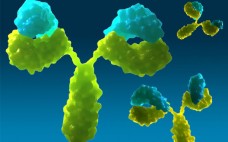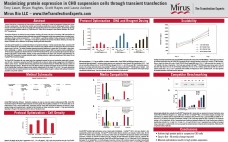Eliminate your outsourcing needs! Gain visibility and control. Learn how the next-generation, high-throughput MicroSEQ® system delivers right-first-time accuracy and give you complete control over microbial identification, by owning the system, the process and data analysis.
Downstream Processing
Charge Heterogeneity Analysis in 10 Minutes
Platform methods, high resolution and ease of use have made the iCE system the gold standard for protein charge heterogeneity characterization for biopharmaceuticals. At 15-18 minutes per sample, iCE methods are already fast and simple but now they are even better. In this white paper we describe a high throughput 10 minute charge heterogeneity analysis method and performance improvements that provide automated analysis of 100 samples at a time.
Maximizing Protein Expression in CHO Suspension Cells Through Transient Transfection
Transient transfection in mammalian cell lines provides an avenue for researchers to bridge the development bottleneck and shorten the time to usable protein. The method also maintains post translational modifications crucial for biotherapeutic function. Chinese Hamster Ovary (CHO) suspension cells are especially suited for high yield production of recombinant proteins, despite being refractory to commonly used transfection methods (e.g. 25kDa linear PEI). Mirus Bio has developed a more effective alternative, the TransIT-PRO® Transfection Kit. Transfection efficiencies are affected by many…
Purification of Oligonucleotides on TOYOPEARL GigaCap® Q-650S
TOYOPEARL GigaCap Q-650S is capable of delivering oligonucleotides of comparable purity and slightly higher process yields under the same operating conditions to those seen with resins requiring higher operating pressures. This capability allows chromatographers to purify oligonucleotides without the added expense of purchasing high pressure manufacturing equipment.
Biosimilars, Oxidative Damage, and Unwanted Immunogenicity
Concerns about the economic viability of biosimilars center on their high development cost relative to small-molecule generics, along with (and partly because of) the difficulty in demonstrating bioequivalence for these complex molecules. Immunogenicity is a particular area of increasing vigilance at both the US Food and Drug Administration (FDA) and the European Medicines Agency (EMA) (1, 2). Unwanted immunogenicity is an underlying cause of multiple deleterious effects for all protein-based therapeutics — including loss of efficacy, altered pharmacokinetics, and reduced…
Increasing Purity and Yield in Biosimilar Production
Current downstream processing strategies for recombinant proteins often require multiple chromatographic steps, which may lead to poor overall yields. Product purification can be especially difficult when a target protein displays reduced stability, forms isoforms or misprocessed variants, or needs to be purified from a complex mixture containing a high degree of contaminants. One technology that has been developed to tackle such limitations is based on custom-made chromatography matrices containing camelid-based single-domain antibody fragments. With a molecular weight of only 12–15…
A Salt-Tolerant Anion-Exchange Chromatography Sorbent for Flexible Process Development
In most downstream purification processes designed for biopharmaceutical drug production, dilution and diafiltration sequences are unavoidable. Such operations are routinely used to adjust a feedstock or chromatographic fraction to the optimal conditions required for best process performances. Nevertheless, those steps are often time, water, and labor consuming without participating directly in final product purification. Because biopharmaceutical production is increasingly driven by cost reduction, a possible means for enhancing process economics is to streamline purification by eliminating these unit operations before…
Broadening the Baseline
When the editors of BPI asked us at BPSA to put together a content-rich article on single-use issues, we were happy to do so. Our challenge was how to bring in multiple viewpoints about the growing business of single-use that would be a “quick read” for the BPI audience. The answer: an expert colloquy. Represented here are several of the most qualified industry spokespersons in single-use — all are members of BPSA and speak as directors of the alliance. Their…
“Transformation By Infection”
Every bioprocess begins with an expression system, and every expression system begins with DNA transfection. Derived from transformation and infection, the word paradoxically has come to be applied mainly to nonviral methods of genetically engineering cells; viral-vector–mediated DNA transfer is often called transduction. There are chemical, particulate, physical/mechanical, and viral means of getting new genetic material into a cell, and that DNA may take a number of different forms. Even the cloning method (pictured right) using a microscopic needle to…
Purifying Common Light-Chain Bispecific Antibodies
A bispecific antibody can bind two different antigens. Immunoglobulin G (IgG) type antibodies have two binding sites with different variable regions. An IgG variable region is made up of a variable light-chain sequence (VL) and a variable heavy-chain sequence (VH). The light chains (LCs) of common LC antibodies are identical for both variable regions, leaving the heavy chain (HC) for generating different specificities. Thus, recombinant host cells for production of common LC bispecific antibodies carry genes for both HCs, with…




